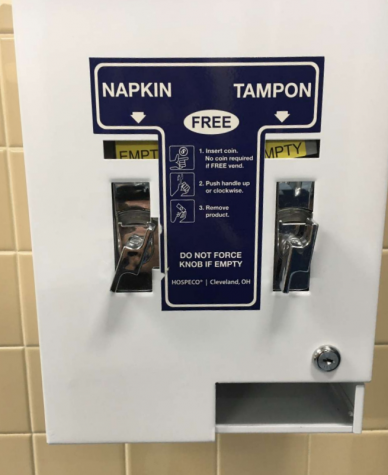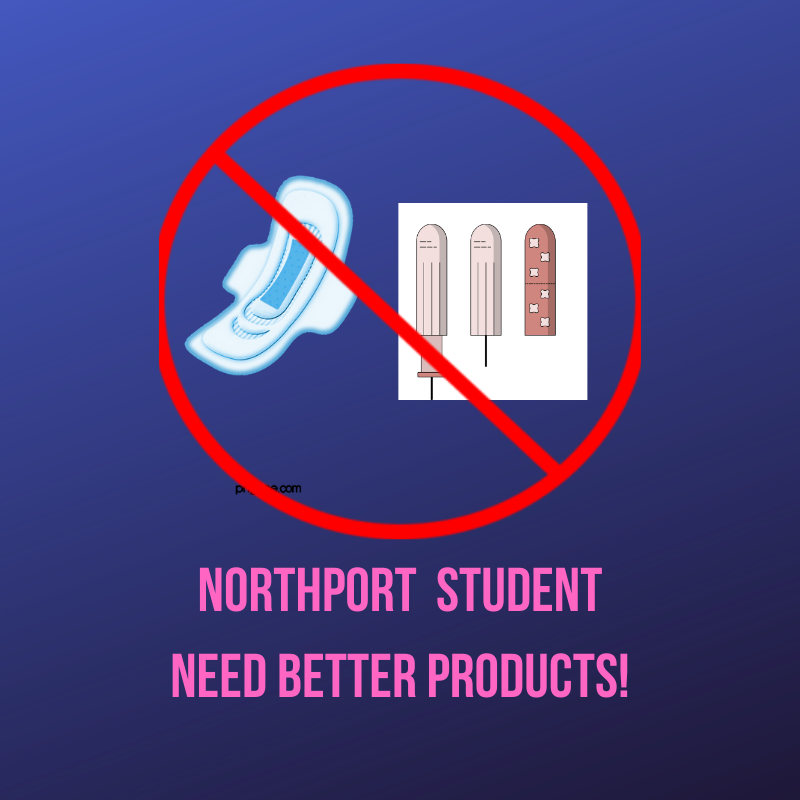Northport Students Deserve Quality Menstrual Products. Period.
How administrators clashed with a state memo, costing students the menstrual products they need
NHS Students need better products available to them.
January 9, 2020
On July 1st, 2018, Governor Andrew Cuomo unveiled a piece of legislation that guarantees free feminine hygiene products in all public schools. This is part of a greater effort by Cuomo’s office to fight for gender equality as part of his Women’s Opportunity Agenda. In a memo detailing the legislation that was delivered to superintendents of New York State school districts, Kathleen R. DeCataldo, the New York State Education Department’s Assistant Commissioner for the Office of Student Support Services, stated that the law requires “all elementary and secondary public schools in New York State … to provide feminine hygiene products to students in school restrooms, at no cost”. However, in attempting to comply with this new legislation, the Northport-East Northport School District made a number of mistakes that have resulted in poor quality feminine hygiene products for students and a lack of availability and variety in those products.
To understand the consequences of providing poor feminine hygiene products, it’s necessary to recognize the benefits of providing free menstrual products in school.
First and foremost, the provision of free menstrual products reduces the number of school days missed by female students. The World Bank explains that “A growing body of evidence shows that girls’ inability to manage their menstrual hygiene in schools, results in school absenteeism”. Aunt Flow, an organization committed to providing equal access to menstrual hygiene products, found that absenteeism was reduced by 2.4% in New York City public schools when these products were offered in bathrooms.
Providing free menstrual products also benefits female students from lower income families who, due to financial constraints, don’t necessarily have access to these products. An article by Nadya Okamoto and Maria Molland describes how “one-in-five teens have struggled to afford period products or have not been able to purchase them at all, and one-in-four teens have missed class due [sic] the lack of access to menstrual hygiene products”. The United Nations has even declared access to menstrual hygiene to be a human right. In recognizing this, New York State mandated that every public school make menstrual hygiene products available to female students for free.
There are two main types of menstrual hygiene products specifically recognized in DeCataldo’s memo: menstrual pads (or sanitary napkins) and tampons. Both are used to manage menstrual flow and are recognized products. While tampons are the primary product used by 70% of women in the United States, the district is only supplying pads. In addition, students have complained about the quality of the products made available to them in the girls’ bathrooms and the Health Office.
Nicole Mezzasalma, a Northport High School junior, explained that the menstrual pads supplied by the school are “highly uncomfortable”, causing her to avoid using them – a sentiment agreed upon by many other students. Another female student, who requested anonymity due to the personal nature of this article, explained that students go as far as to “use their own supplies”, due to the poor quality of menstrual pads. Furthermore, the pads provided, identified as Maxithins and Gards brand pads, are only offered in a single size and don’t have wings, a feature many girls and women find necessary for handling their period. As Mezzasalma explains, providing a single type of menstrual pad simply doesn’t cut it. She says schools should offer pads of “different sizes because every girl is different”. Elaborating, she describes that “what is already provided at schools is like a ‘one size fits all’ kinda thing, but unfortunately it doesn’t”. The lack of quality and variety seen in these products defeats the purpose of providing them to students; many are forced to rely on their own supply instead.
In addition to the poor quality of the pads, students have complained about a lack of alternative products, with many noting that the product dispensers in the bathrooms never contain tampons. Gus Mantia, the Head Custodian at Northport High School, explained the absence of the product, attributing it to the fact that “We [the school district] don’t provide tampons”. The Health Office of the High School also lacks tampons. Marianne Memole, a nurse from the Health Office, explained that they receive their products from the same janitorial staff who stock the bathrooms. While choosing to supply pads instead of tampons follows the letter of the law, it is not in the law’s spirit and is counterproductive to the goals of the legislation as outlined in DeCataldo’s memo, which explicitly includes tampons in its list of feminine hygiene products that should be provided to students.
Students have also complained about menstrual pads being in low supply, claiming that “it seems as if having the products at school is a waste, because whenever someone needs them there are none left”. Mantia explained that a “dispenser holds 16 packages” and that “they are filled daily as needed”, adding that these refills “could be once a day or more as needed”. However, with so many students using each bathroom, it’s difficult to imagine a scenario in which dispensers are replenished often enough to serve every student in need of these materials.

“Menstrual products are essential items we need to manage our health and manage our productivity”, explains Jennifer Weiss-Wolf, the Vice President for Development at the Brennan Center for Justice. She notes that providing free tampons and pads to students is “a small price to pay to keep girls in class”. The lack of tampons or good quality pads contributes to the stigma surrounding menstruation and can make female students feel uncomfortable around their peers. As another female student at the high school explains, “there’s not much privacy [for students] when taking them [menstrual pads] from their own bags”, a problem perpetuated by the fact that many students aren’t permitted to bring their bags to the bathroom.
The question then remains: who is responsible for the decision to provide only one type of menstrual pad to students? The memo from DeCataldo explains that schools should determine what products to provide “in consultation with their school nurse or medical director”. However, Ms. Memole explained that the school’s nurses “did not have a say in the selecon [sic] of feminine hygiene products”. Mark Dantuono, the Director of Health, Physical Education & Athletics had the same response. Even Dr. Roger Perrone, the district’s Chief Medical Officer who “advises the Northport School District on all medical issues”, was not consulted.
John Moran, the Chief Custodian for the district, says he made the decision. He explained that, “When the new legislation came out, we were instructed by the Director of Student Support Services [Cynthia M. Fitzgerald at the time] to ensure compliance. Based off of that guidance, I shared what my intentions were and made the purchases”. The assignment of this important task to a custodian, rather than to health personnel, violates the instructions that were put forth in the memo sent by the New York State Education Department. The result of this action is as expected: the selection of a single type of pad that is thick, uncomfortable, and potentially unusable for certain students.
When it came to a solution for this problem, students gave a variety of suggestions. Some proposed that “The machines [referring to the product dispensers in the bathrooms] should also be constantly refilled when possible”, while others demanded that “some higher power [referring to elected officials and state legislators] should be taking a stand on this.” The disparities in the resolutions aside, almost every student agreed that the school should be providing tampons and a larger assortment of pads.
“Schools are always saying they want the best for their students,” says Mezzasalma. They just “really [are] not paying attention to the little things that are very important.”
Note: A number of student sources were granted anonymity, due to the sensitive and personal nature of the questions asked. Professional journalistic standards for anonymous sourcing were followed, with each statement being confirmed by additional sources.



Tara D’Amico • Jan 9, 2020 at 5:29 pm
I think this brings to light a real issue that needs to be rectified. Access to free menstrual products, that are of the quality that is needed to be productive, is essential to half of the student body and I think more action needs to be taken to make sure that this does get done. Thank you for taking your time to research and take a stand on this, it is greatly appreciated.